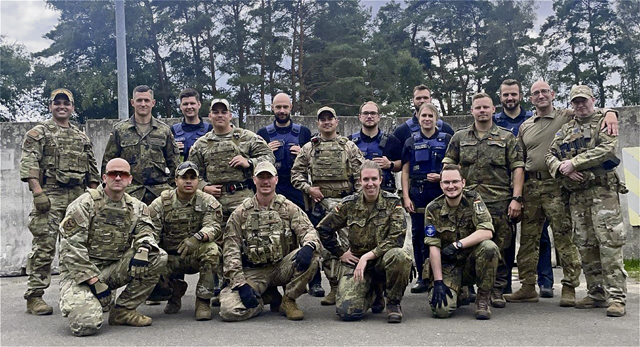
Members of Police Inspection 2 in Kaiserslautern, the Bundeswehr and Security Forces recently took part in a three-day seminar at Ramstein Air Base. Based on various joint police operations, the group trained under the motto “Training together — learning from each other.”
Participants eagerly welcomed the joint training opportunity after an extensive break due to the pandemic. The two-phase event was organized and led by Marco Lorenz and Steffen Potschang, two German speaking training instructors with the 86th Airlift Wing Security Forces.
The exercise included tactical first aid, law enforcement techniques, one and two-man fights, room searches and clearance. The first part focused on the topic emergency medical care, also known as TCCC – Tactical Combat Casualty Care in military terms. The 86th Medical Group supported the exercise with realistic dummies to create a scenario as authentic as possible. U.S. Forces had gained twenty years of experience since the war in Afghanistan and its well-developed first aid strategy was bundled into a joint concept to enable a uniform training experience together with their German police and armed forces colleagues.
First as theoretical instruction, participants were then directly able to deepen their knowledge with practical exercises. These involved treating wounds with broken or severed limbs and strong bleeding, problems with blood circulation or stabilizing patients under shock. In particular, the trainers made sure that only materials contained in the LebEL-Notfalltasche (German emergency kit) were used. The realistic dummies provided by the Medical Group with blood circulation, a pulse and blood pressure were especially impressing and strongly resembled actual casualties during the training.
In the second part the participants practiced various training scenarios focusing on the topic “PO CQB – Police Officer Close Quarter Battle.” Additional members of the Security Forces and Bundeswehr joined in this portion of the exercise. The training began with theoretical instruction of tactical procedures in buildings. An empty part of a former high school building and a recently modernized training bunker were used for this phase of the exercise. This created a valuable learning experience in enclosed rooms with moving targets which could, in real life incidents, actually shoot back at the participants.
The 86th Security Forces S3T Training unit consists of three German instructors and five U.S. personnel. Lorenz and Potschang are responsible for planning and conducting eight-week initial training courses for newly assigned German civilian personnel as well as routine sustainment training throughout the year.
Security forces team colleagues commented that they looked forward to further training opportunities with German partners and friends and pointed out that the exercise supports General James B. Hecker’s, United States Air Forces and Air Forces Africa commander, priority of partnerships. “After three days of intense impressions during the joint training, we are grateful that we could even intensify our long-standing excellent relationship with U.S. colleagues,” Johannes Grub, inspector at Police Inspection 2 in Kaiserslautern, commended.
Further valuable joint trainings with the Security Forces, the Bundeswehr and the Polizei are currently in planning.


